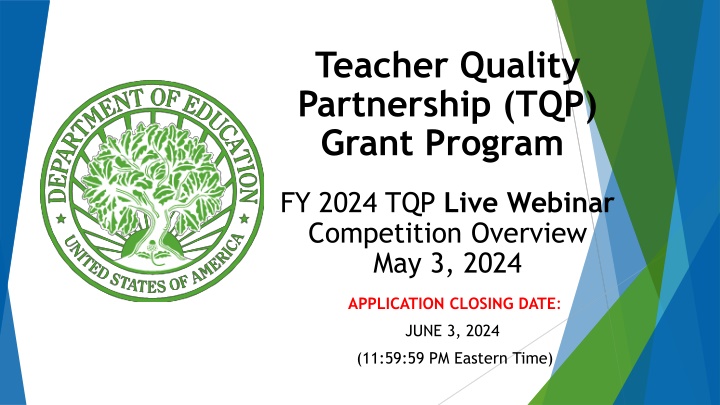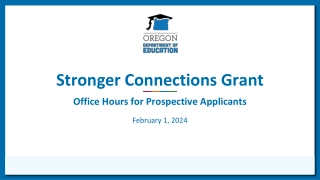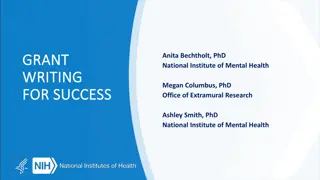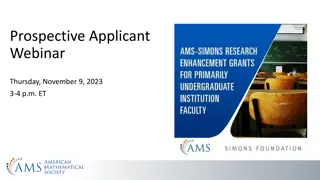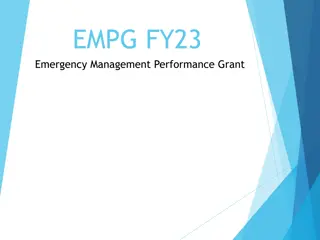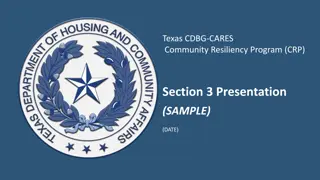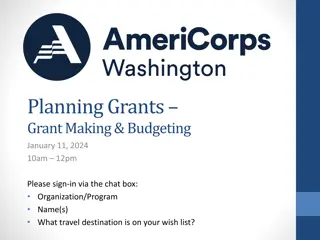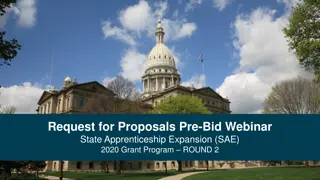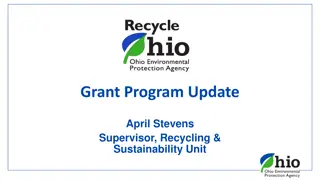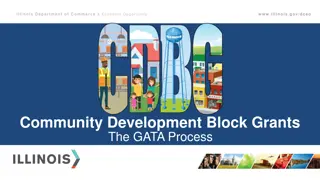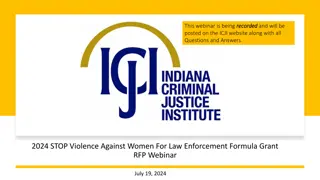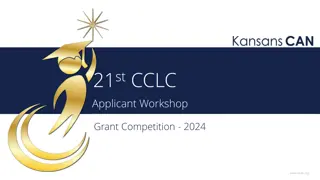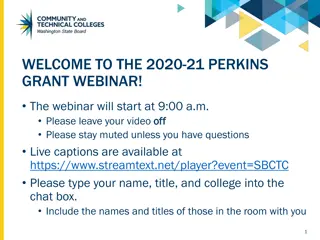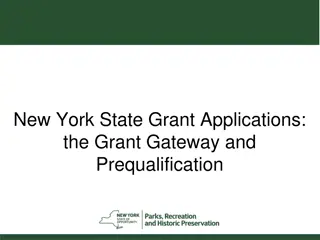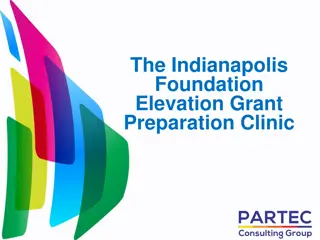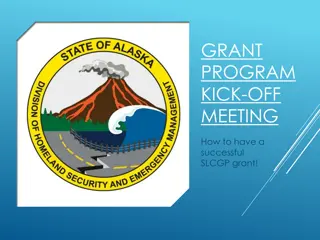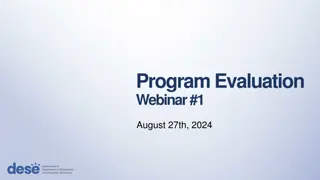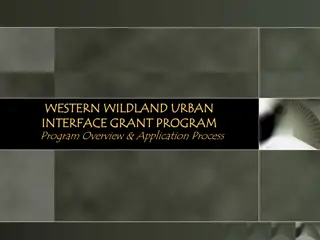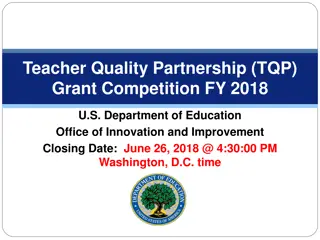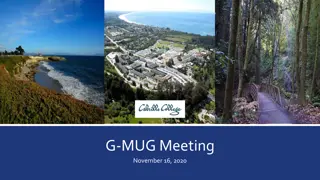FY 2024 TQP Grant Program Overview
The Teacher Quality Partnership (TQP) Grant Program for Fiscal Year 2024 aims to enhance educator quality through a competitive grant process. Applicants must comply with specified requirements detailed in the application instructions. Resources are provided to guide interested parties through the application process, including eligibility checklists and informational webinars. The program's purpose, priorities, selection criteria, performance measures, and budget guidelines are outlined to assist applicants in submitting successful proposals.
Download Presentation

Please find below an Image/Link to download the presentation.
The content on the website is provided AS IS for your information and personal use only. It may not be sold, licensed, or shared on other websites without obtaining consent from the author.If you encounter any issues during the download, it is possible that the publisher has removed the file from their server.
You are allowed to download the files provided on this website for personal or commercial use, subject to the condition that they are used lawfully. All files are the property of their respective owners.
The content on the website is provided AS IS for your information and personal use only. It may not be sold, licensed, or shared on other websites without obtaining consent from the author.
E N D
Presentation Transcript
Teacher Quality Partnership (TQP) Grant Program FY 2024 TQP Live Webinar Competition Overview May 3, 2024 APPLICATION CLOSING DATE: JUNE 3, 2024 (11:59:59 PM Eastern Time)
Getting Started! Applicants should review the FY 2024 TQP Notice Inviting Applications (NIA) published in the Federal Register on April 4, 2024. Applicants should review and download the TQP Application Instructions Package from the TQP webpage. The TQP Application Instructions Package provides additional instructions and guidance when applying for the 2024 TQP grant. This current slide deck is comprised of all 4 pre-application slide decks. See the program website for all four individual slide decks. Note: These slides are intended as technical assistance and do not impose any requirements beyond those included in the program statute, TQP NIA, or other applicable regulations. For more information, please refer to the official documents published in the Federal Register.
TQP Competition Resources TQP Program Website: https://oese.ed.gov/offices/office-of- discretionary-grants-support-services/effective-educator-development- programs/teacher-quality-partnership/ FY 2024 TQP Notice Inviting Applications (NIA) o FY 2024 TQP Application Instructions Package o FY 2024 TQP FAQ Documents (2) o FY 2024 TQP Informational Webinars (4) o Required TQP Program Checklists (2) o Required Effective Educator Development (EED) Applicant/Grantee o Budget Worksheet Send all competition questions to the TQP Inbox at: TQPartnership@ed.gov
REQUIRED TQP Program Checklists and Budget Worksheet 1. TQP Eligibility Checklists (2) 2. TQP Application and General Program Requirements Checklist 3. TQP Absolute Priority Checklist (select 1 of 4) 4. EED Applicant/Grantee Budget Worksheet All checklists and Budget Worksheet are found on the TQP program website and must be submitted at the time of application.
TQP Webinar Agenda I. TQP Program Purpose and Statute II. TQP Eligibility Requirements III. TQP General Application Requirements and Program Requirements IV. TQP Program Priorities V. TQP Selection Criteria and Scoring VI. TQP Performance Measures and Reporting VII. TQP Application Process VIII. TQP Budget Cost Principles IX. TQP Budget Guidance X. TQP 2% Administrative Cost Cap XI. TQP Competition Reminders 5
TQP Program Purpose and Statute
TQP Program Statute The Teacher Quality Partnership program statute is contained in Title II of the Higher Education Act (HEA), as amended on August 14, 2008, by the Higher Education Opportunity Act (Public Law 110-315) Access the TQP program statute: https://www.govinfo.gov/content/pkg/COMPS-765/pdf/COMPS- 765.pdf
To improve student achievement; To improve the quality of prospective and new teachers by improving the preparation of prospective teachers and enhancing professional development activities for new teachers; To hold teacher preparation programs at institutions of higher education accountable for preparing teachers who meet the applicable State certification and licensure requirements, including any requirements for certification obtained through alternative routes to certification, or, with regard to special education teachers, the qualifications described in section 1412(a)(14)(C) of the Individuals with Disabilities Education Act; and To recruit highly qualified individuals, including minorities and individuals from other occupations, into the teaching force. TQP Program Purposes: 8
TQP Eligibility Requirements
The Eligible Partnership Eligible Applicants must be an eligible partnership as defined in HEA section 200(6): High-Need Local Education Agency (LEA(s)) Partner Institution College/School of Education within the Partner Institution High-Need School(s) served within the High-Need LEA(s) College/School of Arts and Sciences within the Partner Institution All five (5) entities must be included as part of the eligible partnership 10
Other OPTIONAL Entities for the Eligible Partnership (B) may include any of the following: (ix) A high-performing local educational agency, or a consortium of such local educational agencies, that can serve as a resource to the partnership. (i) The Governor of the State. (ii) The State educational agency. (x) A charter school (as defined in section 7221i of this title) (or ESEA section 4310). (iii) The State board of education. (iv) The State agency for higher education. (xi) A school or department within the partner institution that focuses on psychology and human development. (v) A business. (vi) A public or private nonprofit educational organization. (xii) A school or department within the partner institution with comparable expertise in the disciplines of teaching, learning, and child and adolescent development. (vii) An educational service agency. (viii) A teacher organization. (xiii) An entity operating a program that provides alternative routes to State certification of teachers.
TQP Eligibility Components High-Need Local Education Agency (LEA)(s) Poverty/Rural Status and Teacher Need Data High-Need School(s) served within the High-Need LEA(s) See slides 16 and 17 Documentation of these eligibility requirements must be submitted at the time of application 12
Poverty Data/Rural Status High need LEA data may be documented in one of the following ways below, the data provided must be the most recent data available. Census data (or other comparable data) showing LEA serves 20% or more children from low-income families Small, Rural School Achievement (SRSA) program under section 5211(b) of the ESEA Census data (or other comparable data) showing LEA serves 10,000 or more children from low- income families Rural and Low-Income School (RLIS) program under section 5221(b) of the ESEA
Teacher Need Data High need LEA data may be documented in one of the following ways below, the data provided must be the most recent data available. High percentage of teachers not teaching in the academic subject areas or grade levels in which the teachers were trained to teach High teacher turnover rate High percentage of teachers with emergency, provisional, or temporary certification or licensure
High-Need School Data High need school data may be documented in the following ways below, the data provided must be the most recent data available. (I) The percentage of students aged 5 through 17 in poverty counted in the most recent census data approved by the Secretary. The percentage of students eligible for a free or reduced-price school lunch (FRPL) under the Richard B. Russell National School Lunch Act [42 U.S.C. 1751 et seq.]. (III) The percentage of students in families receiving assistance under the State program funded under part A of title IV of the Social Security Act [42 U.S.C. 601 et seq.]. (IV) The percentage of students eligible to receive medical assistance under the Medicaid program. (V) A composite of two or more of the measures described in subclauses (I) through (IV). In highest quartile of schools in LEA: (II)
High-Need School Data High need school data may be documented in the following ways below, the data provided must be the most recent data available. Elementary Schools - 60% or more of students eligible for FRPL Not an Elementary School - 45% or more of students eligible for FRPL
Required TQP Eligibility Checklists The Eligible Partnership Checklist is 1 of 2 eligibility checklists. Checklists are required and must be submitted at the time of application. These checklists help the program team to determine if all eligibility requirements have been met. Checklists can be found on the TQP program website. 17
Required TQP Eligibility Checklists The Partner IHE Eligibility Checklist is 2 of 2 eligibility checklists. Checklists are required and must be submitted at the time of application. These checklists help the program team to determine if all eligibility requirements have been met. Checklists can be found on the TQP program website. 18
TQP General Application and Program Requirements
TQP General Application Requirements Location in Statute Possible Location to include in Project Narrative Program Requirement Needs Assessment HEA section 202(b)(1) Appendix B Description of Project HEA section 202(b)(2,3,6(A) & (F-J)) May address as part of the Quality of the Project Design Description of coordination strategies and alignment with State and student academic achievement standards HEA section 202(b)(4) May address as part of the Quality of the Project Design Assessment of resources available HEA section 202(b)(5) May address as part of the Quality of the Management Plan, Adequacy of Resources, and Budget Narrative Description of Evaluation Plan HEA section 202(b)(6(D) & (K)) May address as part of the Quality of the Evaluation Plan
Needs Assessment Eligible Applicants must conduct a needs assessment of the proposed eligible partnership . The needs assessment should influence the type of TQP project being proposed. The needs assessment should help determine the types of teachers being prepared to meet the needs of the partner LEA(s) and schools. The needs assessment will also help determine what type of ongoing training and professional development needed to recruit, train, and retain teachers in the partner LEAs and schools. If the eligible applicant is addressing AP 1 or AP 3, the needs assessment should help to determine what reform(s) need to be made at the College of Education within the partner IHE. The Needs Assessment is not a part of the project narrative; the needs assessment must be uploaded separately into Appendix B. 21
Description of the Project Describe how the partnership will prepare teachers: With strong teaching skills To use research and data to modify and improve classroom instruction To teach students with disabilities, including as a member of IEP team under IDEA To teach English Learners Describe how Partner Institution faculty will work with LEA teachers to train other classroom teachers to implement literacy programs. Describe how applicant will design, implement, or enhance a year-long rigorous teaching pre-service clinical component. Describe how the applicant will support in-service professional development activities. 22
Description of Coordination Strategies and Alignment with State and Student Academic and Achievement Standards Description must include how the partnership plans to: Coordinate strategies with other professional development programs, including those that are funded under ESEA, IDEA, and other Federal sources Have activities that are consistent with State ESEA academic content standards, State Early Childhood Education (ECE) standards and domains Correspond with the goal of improving student academic achievement 23
Assessment of Available Resources Application needs to describe resources available to the partnership: Integration of funds from related sources Intended use of grant funds Commitment of the resources of the partnership to required project activities 24
Description of Evaluation Plan Application needs to describe: The evaluation plan under section 204(a) of the HEA How the partnership will collect, analyze, and use data on retention to evaluate the effectiveness of the partnership s teacher support systems 25
Section 203(c)(1) of HEA, requires that each grantee provide matching funds from non-Federal sources that equal 100% of the Federal TQP grant award. In other words, the grantee must provide a dollar of matching funds for each dollar of Federal grant funds received. Match funds share the Federal government s cost for programs with State and local agencies and the private sector; and Match funds promote the sustainability of programs after Federal funding has ended. TQP 100% Non-Federal Match Requirement: *Federal funds should be viewed as seed money to fund work that will continue to impact partner districts long after federal funding ends. 26
Match funds must be from non-Federal sources. (i.e. project partners and other nonfederal contributors) Match funds may be cash or in-kind contributions. In-Kind or non-cash contributions provided by the applicant or non-Federal partners typically have a calculated value for personnel, goods, and/or services, including direct and indirect costs. Match funds should be incorporated into the total cost of your proposed project, not added on top of cost of the proposed project. Eligible Applicants may not use unrecovered indirect costs towards meeting the match/cost share requirement without receiving prior approval from the Department. Where do Non-Federal Match funds come from? 27
FY 2024 TQP Absolute Priorities
TQP Program Priorities Priority Number Notes Applicants must select only select 1 AP to address. Applicant may address as many CPPs as they like. Points will be awarded based on quality of the response Applicant may address as many IPs as they like. Points will not be awarded. Absolute Priorities (AP) 4 Competitive Preference Priorities (CPP) 4 Invitational Priorities (IP) 2 30
AP1: Partnership Grants for the Preparation of Teachers (Pre-Bac Model)
Pre-Bac Model Requirement Highlights Pre-Bac models must reform ALL or an IDENTIFIED PART of IHE s teacher preparation program Pre-bac model reforms must be completed within the life of the proposed grant period Pre-Bac models must recruit teacher candidates based on the needs of the partner high-need LEA Pre-Bac models must provide a year-long (academic year) clinical experience Pre-Bac models must provide a 2-year induction program Pre-Bac models must support and train teacher candidates Pre-Bac model participants (teacher candidates) must be placed in cohorts to facilitate professional collaboration Pre-Bac models may include a 5th year licensing program Pre-Bac models may change/develop program curriculum *Applicants must use the Required TQP Absolute Priority Checklist to document where all Absolute Priority Requirements can be found in the application. (See Section 202(d) of the HEA for full Absolute Priority language.) 32
AP2: Partnership Grants for the Establishment of Effective Teaching Residency Programs (Residency Model)
Residency Model Requirement Highlights Residency models must establish a new or redesign existing teaching residency programs. Residency models must have a rigorous selection criteria for residents and mentor teachers. Residency models must provide a master's degree program designed to be completed by residents within 18-months. Residency models must include a year-long (academic year) clinical experience. Residency models must offer a one-year Living Wage Stipend/Salary (LWS). Residents must complete a 3-year service agreement with the partner high- need LEA; if not, LWS must be repaid. Residency models must provide at least a 2-year induction program. Residency models must provide training and support for teaching residents Residency model participants (Residents) must be placed in cohorts to facilitate professional collaboration Applicants must use the Required TQP Absolute Priority Checklist to document where all Absolute Priority Requirements can be found in the application. (See Section 202(e) of the HEA for full Absolute Priority language.) 34
AP4: Partnership Grants for the Development of Leadership Programs in Conjunction with the Establishment of an Effective Teaching Residency Program under Absolute Priority 2 (Residency Model with Leadership) AP3: Partnership Grants for the Development of Leadership Programs in Conjunction with the Preparation of Teachers under Absolute Priority 1 (Pre-Bac Model with Leadership)
Leadership Model Requirement Highlights Leadership models must be implemented with a new Pre-Bac or Residency Model. The Leadership model is not a stand-alone model. Leadership models must be part of the same proposed project of the Pre-Bac or Residency Model, and applicants must include how TQP grant funds will be used to support both the leadership models and Pre- Bac or Residency Model. Leadership models must prepare individuals for careers as superintendents, principals, Early Childhood Education (ECE) program directors, or other school leaders. Leadership models must promote strong leadership skills and, as applicable, techniques for school leaders. Leadership models must develop and improve a sustained and high- quality preservice clinical education program to further develop the leadership skills of all prospective school leaders involved in the program. Leadership models must create an induction program for new school leaders 36
Leadership Model Requirement Highlights Leadership models must ensure that individuals who participate in the school leadership program receive (i) Effective preservice preparation (ii) Mentoring; and (iii) If applicable, full State certification or licensure to become a school leader. Leadership models must develop and implement effective mechanisms to ensure that the eligible partnership is able to recruit qualified individuals to become school leaders An eligible partnership may carry out the school leadership program either in the partner high-need LEA or in further partnership with an LEA located in a rural area. Applicants must use the Required TQP Absolute Priority Checklist to document where all Absolute Priority Requirements can be found in the application. (See Section 202(f) of the HEA for full Absolute Priority language.) 37
FY 2024 TQP Competitive Preference Priorities
COMPETITIVE PREFERENCE PRIORITY 1 INCREASING EDUCATOR DIVERSITY (UP TO 4 PTS) Improve the recruitment, outreach, preparation, support, development, and retention of a diverse educator workforce. Increasing Educator Diversity Adopt, implement or expand high- quality, comprehensive teacher preparation programs in HBCUs, HSIs, Tribal Colleges/Universities, or other minority serving institutions (MSI). Reforms to teacher preparation programs to improve the diversity of teacher candidates. Possible Priority Activities (one or both) (See the NIA for the full Competitive Preference Priority language.)
COMPETITIVE PREFERENCE PRIORITY 2 SUPPORTING A DIVERSE EDUCATOR WORKFORCE AND PROFESSIONAL GROWTH TO STRENGTHEN STUDENT LEARNING (UP TO 3 PTS) Support Diverse Educator Workforce Increase the proportion of well- prepared, diverse, and effective educators serving students, with focus on underserved students. Increase the number of teachers with certification or dual certification in a shortage area. Advanced certifications from nationally recognized professional organizations. Possible Priority Activities (one or both) (See the NIA for the full Competitive Preference Priority language.) 40
COMPETITIVE PREFERENCE PRIORITY 3 MEETING STUDENT SOCIAL, EMOTIONAL, AND ACADEMIC NEEDS (UP TO 2 PTS) Improve students social, emotional, academic, and career development Creating a positive, inclusive, and identity-safe climate at institutions of higher education. Fostering a sense of belonging and inclusion for underserved students. Implementing evidence-based practices for advancing student success for underserved students. Possible Priority Activities (one or more) (See the NIA for the full Competitive Preference Priority language.)
COMPETITIVE PREFERENCE PRIORITY 4 PROMOTING EQUITY IN STUDENT ACCESS TO EDUCATIONAL RESOURCES AND OPPORTUNITIES (UP TO 2 PTS) Promote educational equity and adequacy in resources and opportunity for underserved students. Equity in Student Access See NIA language for a complete list of service areas and populations. Possible Priority Activities (one or both) (See the NIA for the full Competitive Preference Priority language.)
FY 2024 TQP Invitational Priorities
INVITATIONAL PRIORITY #1 PARTNERSHIP GRANTS FOR THE ESTABLISHMENT OF GYO PROGRAMS AND REGISTERED APPRENTICESHIP PROGRAMS FOR K-12 TEACHERS. Projects that establish or scale evidence- based and high quality GYO programs, including through a registered apprenticeship programs, that are designed to address shortages of teachers in high- need areas, schools, and/or geographic areas, or shortages of school leaders in high- need schools, and increase the diversity of qualified individuals entering the teacher, principal, or other school leader workforce, by recruiting and developing teacher candidates from the communities the school or district serves... (please see NIA for complete invitational priority language) Grow Your Own
INVITATIONAL PRIORITY #2 SUPPORTING EARLY ELEMENTARY EDUCATORS AND SCHOOL LEADERS Projects that include professional development programs, professional learning communities, and peer learning collaboratives to support elementary educators and school leaders in meeting the wide range of developmental strengths, needs, and experiences of students at kindergarten entry through the early grades with a focus on one or more of the following strategies... (please see NIA for complete invitational priority language) K-2 Educators and School Leaders
TQP Selection Criteria and Scoring
TQP Selection Criteria Point Allocation Selection Criteria Max Points Quality of Project Design 30 Quality of Project Evaluation 20 Adequacy of Resources 30 Quality of Management Plan 20 Total 100 11 111 Competitive Preference Points Total Possible Points 48
Quality of Project Design (up to 30 pts) The extent to which goals, objectives, and outcomes to be achieved by the proposed project are clearly specified and measurable. The extent to which performance feedback and continuous improvement are integral to the design of the proposed project. The extent to which the proposed project demonstrates a rationale. (see Logic Model slide) The extent to which the proposed project is designed to build capacity and yield results that will extend beyond the period of Federal financial assistance. The extent to which the proposed project is part of a comprehensive effort to improve teaching and learning and support rigorous academic standards for students. The extent to which the design of the proposed project reflects up-to- date knowledge from research and effective practice. 49 Please see TQP NIA for full Selection Criteria language.
What is a Logic Model A Logic Model is also referred to as a theory of action, means a framework that identifies key project components of the proposed project (i.e., the active ingredients that are hypothesized to be critical to achieving the relevant outcomes) and describes the theoretical and operational relationships among the key project components and relevant outcomes. Demonstrates a Rationale means a key project component included in the project's logic model is informed by research or evaluation findings that suggest the project component is likely to improve relevant outcomes. Logic models communicate a project s vision, objectives, and goals to their internal team and stakeholders. Logic Models can be used in program planning, implementation, evaluation, and communication. Logic Models reflect the goals and activities in the grantee s application. Logic Models identify the grantee s projects and expected outcomes. Eligible Applicants should include a logic model at the time of application in Appendix C. Resource: https://ies.ed.gov/ncee/edlabs/regions/pacific/elm.asp
